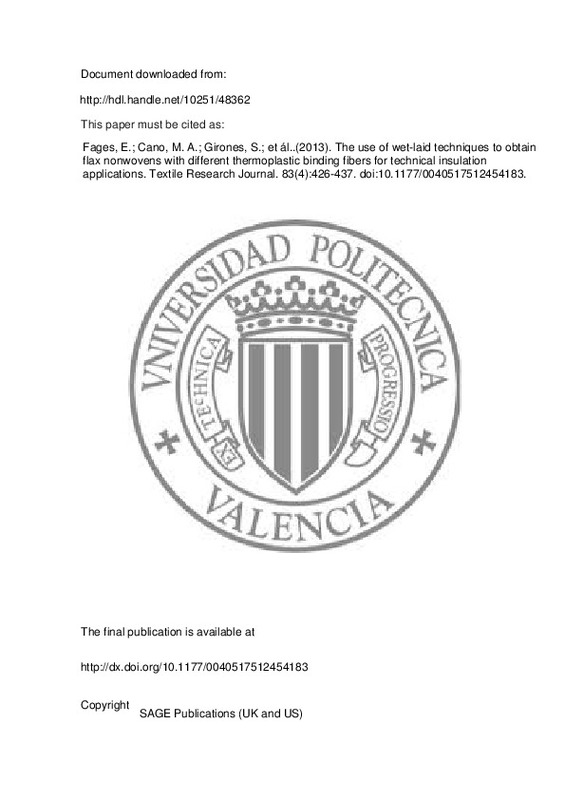JavaScript is disabled for your browser. Some features of this site may not work without it.
Buscar en RiuNet
Listar
Mi cuenta
Estadísticas
Ayuda RiuNet
Admin. UPV
The use of wet-laid techniques to obtain flax nonwovens with different thermoplastic binding fibers for technical insulation applications
Mostrar el registro sencillo del ítem
Ficheros en el ítem
| dc.contributor.author | Fages, E.
|
es_ES |
| dc.contributor.author | Cano, M. A.
|
es_ES |
| dc.contributor.author | Gironés, S.
|
es_ES |
| dc.contributor.author | Boronat Vitoria, Teodomiro
|
es_ES |
| dc.contributor.author | Fenollar Gimeno, Octavio Ángel
|
es_ES |
| dc.contributor.author | Balart Gimeno, Rafael Antonio
|
es_ES |
| dc.date.accessioned | 2015-03-26T15:09:18Z | |
| dc.date.available | 2015-03-26T15:09:18Z | |
| dc.date.issued | 2013-03 | |
| dc.identifier.issn | 0040-5175 | |
| dc.identifier.uri | http://hdl.handle.net/10251/48362 | |
| dc.description.abstract | [EN] In this work, the wet-laid technique has been used to obtain flax nonwovens thermally bonded with different contents of polyvinyl alcohol (PVA) and bicomponent polyamide 6/copolyamide (PA6/CoPA) fibers in the 10-30 wt.% range. Scanning electron microscopy has been used to evaluate the formation of interlock points through melted polymer and flax fibers. Volume porosity has been estimated through determination of thickness and surface mass. Tensile strength and elongation at break have been determined on longitudinal (preferential) and transversal directions to evaluate anisotropy. The sound absorption properties of stacked sheets of flax: PVA and flax: PA6/CoPA nonwovens have been evaluated. In addition, the thermal insulating properties of individual nonwovens have been obtained. Mechanical characterization shows slight anisotropy. The absorption coefficient is interesting in the medium frequencies range, and relatively low thermal conductivity and thermal resistance values are obtained with these nonwovens (in the 0.020-0.025Wm(-1) K-1 range for flax: PVA nonwovens and in the 0.09-0.10Wm(-1) K-1 range for flax: PA6/CoPA nonwovens). By taking into account these features, these nonwoven substrates could find interesting applications as sound absorbers and/or thermal insulation materials in technical applications. | es_ES |
| dc.description.sponsorship | This work is part of the project IPT-310000-2010-037, "ECOTEXCOMP: Research and development of textile structures useful as reinforcement of composite materials with marked ecological character", and was supported by the "Ministerio de Ciencia e Innovacion", with a grant of (sic)189,540.20, within the Plan Nacional de Investigacion Cientifica, Desarrollo e Innovacion Tecnologica 2008-2011 and funded by the European Union through FEDER funds, Technology Fund 2007-2013 and Operational Programme on R + D + i for and on behalf of the companies. The project is also known as "WET-TEX: Implementacion de la tecnologia wet-laid en el desarrollo de nuevos textiles medico-sanitario" with expedient number IMIDIC/2010/137 (total grant of (sic)284,400) and the project "WET-TEX II: Implementacion de la tecnologia wet-laid en la investigacion y desarrollo de paneles para aplicaciones tecnicas a partir de residuos procedentes de la industria textil" with expedient number IMDEEA/2011/167 (total grant of (sic)255,000) funded by IMPIVA and cofunded (80%) by the European Union through FEDER funds, Valencian Community Operational 2007-2012. | |
| dc.language | Inglés | es_ES |
| dc.publisher | SAGE Publications (UK and US) | es_ES |
| dc.relation.ispartof | Textile Research Journal | es_ES |
| dc.rights | Reserva de todos los derechos | es_ES |
| dc.subject | Fiber | es_ES |
| dc.subject | Fabric formation | es_ES |
| dc.subject | Environmental sustainability | es_ES |
| dc.subject | Properties | es_ES |
| dc.subject | Materials | es_ES |
| dc.subject.classification | CIENCIA DE LOS MATERIALES E INGENIERIA METALURGICA | es_ES |
| dc.subject.classification | INGENIERIA DE LOS PROCESOS DE FABRICACION | es_ES |
| dc.title | The use of wet-laid techniques to obtain flax nonwovens with different thermoplastic binding fibers for technical insulation applications | es_ES |
| dc.type | Artículo | es_ES |
| dc.identifier.doi | 10.1177/0040517512454183 | |
| dc.relation.projectID | info:eu-repo/grantAgreement/MICINN//IPT-310000-2010-037/ES/ECOTEXCOMP: Investigación y desarrollo de estructuras textiles aplicables como refuerzo de materiales compuestos de marcado carácter ecológico./ | es_ES |
| dc.relation.projectID | info:eu-repo/grantAgreement/GVA//IMIDIC%2F2010%2F137/ | es_ES |
| dc.relation.projectID | info:eu-repo/grantAgreement/IMPIVA//IMDEEA%2F2011%2F167/ | es_ES |
| dc.rights.accessRights | Abierto | es_ES |
| dc.contributor.affiliation | Universitat Politècnica de València. Instituto de Tecnología de Materiales - Institut de Tecnologia de Materials | es_ES |
| dc.contributor.affiliation | Universitat Politècnica de València. Departamento de Ingeniería Mecánica y de Materiales - Departament d'Enginyeria Mecànica i de Materials | es_ES |
| dc.description.bibliographicCitation | Fages, E.; Cano, MA.; Gironés, S.; Boronat Vitoria, T.; Fenollar Gimeno, OÁ.; Balart Gimeno, RA. (2013). The use of wet-laid techniques to obtain flax nonwovens with different thermoplastic binding fibers for technical insulation applications. Textile Research Journal. 83(4):426-437. https://doi.org/10.1177/0040517512454183 | es_ES |
| dc.description.accrualMethod | S | es_ES |
| dc.relation.publisherversion | http://dx.doi.org/10.1177/0040517512454183 | es_ES |
| dc.description.upvformatpinicio | 426 | es_ES |
| dc.description.upvformatpfin | 437 | es_ES |
| dc.type.version | info:eu-repo/semantics/publishedVersion | es_ES |
| dc.description.volume | 83 | es_ES |
| dc.description.issue | 4 | es_ES |
| dc.relation.senia | 233284 | |
| dc.identifier.eissn | 1746-7748 | |
| dc.contributor.funder | Ministerio de Ciencia e Innovación | |
| dc.contributor.funder | Instituto de la Pequeña y Mediana Industria de la Generalitat Valenciana |







![[Cerrado]](/themes/UPV/images/candado.png)

